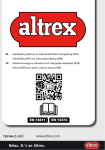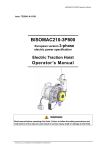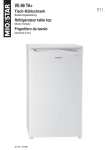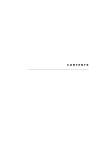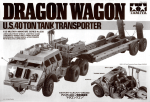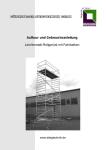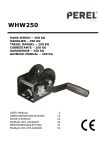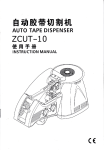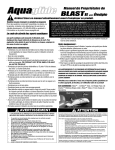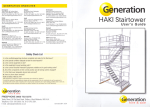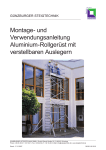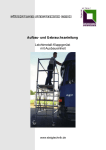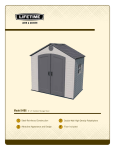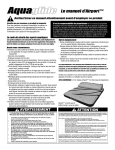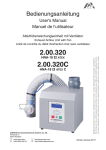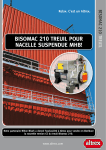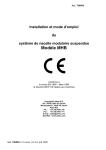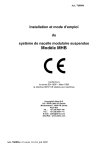Download Relax. It `s an Altrex.
Transcript
EN Manual for assembly and use Modular Triangular Bridge (MTB) MTB with Roof Edge Protection Manual (DRB) DE Aufbau- und verwendungsanleitung Modulare Dreiecksbühne (MTB) und MTB mit Dachrandsicherung (DRB) EN 12811 750147-B-1011 EN 13374 www.altrex.com Relax. It ’s an Altrex. EN Manual for assembly and use Modular Triangular Bridge (MTB) and MTB with Roof Edge Protection (DRB) Art. No. 750147-B-1011 Version 10/2011 Copyright Altrex B.V. © ’11 All rights reserved. No part of this publication may be duplicated, stored in an automated data file, or disclosed in any way or form, whether electronically, mechanically by photocopying, recording, or in any other way, without prior consent from Altrex B.V. Zwolle. This publication may only be used for Altrex products. Misprints and printing errors reserved. Relax. It ’s an Altrex. pag. 2 of 44 General Before use, always read the manufacturer’s (Altrex BV) user manual properly and thoroughly. The load capacity is classified in accordance with class 2 of NEN 12811. The permitted floor load of the MTB upright 3-5 m (331535) is 150 kg/m2, up to a maximum of 500 kg distributed evenly across the floor. For the MTB upright 4-6 m (331536), the permitted floor load is 150 kg/m2 with a maximum of 350 kg distributed evenly across the floor. Do not use the MTB with parts produced by other manufacturers. Only use the MTB with the parts stipulated in this user manual. The assembly and use of the MTB is only permitted at a wind force not exceeding 6 Beaufort (< 14m/s). When used in conjunction with leg posts, the MTB can be used at a minimum platform height of 3 m and a maximum platform height of 5 m or a minimum floor height of 4 m and a maximum floor height of 6 m. Always position the leg post at the correct angle against the wall (approx. 70°). All three feet of the leg post will then be in contact with the ground. Always position the leg post of the MTB on a solid, stable, horizontal and non-slippery surface, with adequate bearing capacity. If the foundation is soft and/or sloping, place a plank and/or ground peg below and/or behind the base of the MTB upright, to prevent it from sliding away. Do not support against a weak wall, such as a synthetic curtain wall. After setting the height of the MTB, always use the securing pin to secure the correct operating height. Allow the work platform to rest on the securing pin. Only then can the work platform support a load. NB: Walking on the work platform before this lock has been fixed in place is not permitted! Always use a ladder to gain access to a secured work platform. When using the weather protection (the Altrex Shelter System) or roof edge protection (Roof Edge Protection - DRB) the leg posts of the MTB and the leg posts of the Shelter System have to be anchored to the wall. Should you wish to use the MTB for reasons other than those mentioned above, you should contact the manufacturer. The MTB system should never be used as a goods and/or passenger lift. When assembling, the following points should be checked: • The load-bearing capacity of the ground surface must be adequate • Any obstructions around the workplace to the assembly and use of the MTB. • The wind force. • The winch cable of the leg posts must be undamaged and neatly rolled • The availability of all required parts at the workplace. • Damaged or incorrect parts must not be used. At least two people should assemble the MTB. Relax. It ’s an Altrex. pag. 3 of 44 EN EN These persons should be appropriately qualified. Only assemble the MTB after these instructions have been read thoroughly. When assembling the MTB, all the required parts have to be used and, after assembly, these should be checked to make sure they are reliably fixed. Use of the operating bridge without guide rails or platforms is not permitted. Deviation from this user manual is not permitted. Use When the MTB is (re)used, the following points have to be checked: • is the structure still complete and in a good condition. • are all fasteners still in place. • does the site still allow safe operation. • are the winch and lifting cable in a good condition. The MTB may only be accessed via a ladder on the side which is supported against the wall. Materials and tools are to be transported to the working platform manually using (for example) a rope and a bucket. These should be lifted as close to the scaffold as possible. The use of hoisting devices to the MTB that are not manually powered is not permitted. The MTB should be raised without a load. Particular attention should be paid to the wind force when using the MTB in wind-susceptible areas, for example open constructions and at the corner of a building. If required, extra fasteners should be used. The MTB can be used as Roof Edge Protection including work platform, or on its own as Roof Edge Protection! Check that the trolley has been reinforced for its intended use in Roof Edge Protection. The trolley has a green sticker (see photo) and can be identified visually by the reinforced connection point of the truss (see photo). Without this reinforced trolley, the MTB upright cannot be used as Roof Edge Protection! Relax. It ’s an Altrex. pag. 4 of 44 Replacing the trolley EN NL If the trolley has to be replaced, the following instruction applies: 1. Ensure there is some play in the cable. 2. Disassemble the eye of the cable on the trolley. 3. Remove the cable. 4. Take the upright apart. 5. Remove the “old” trolley and fit the reinforced trolley with green sticker. 6. Reassemble the upright. As Roof Edge Protection, the MTB is can be added to. Between the two ends of the MTBs with Roof Edge Protection guardrail brace uprights, the space must be no more than 10 cm. If a person or object falls into the Roof Edge Protection system, the entire system can only be used once an inspection has been performed by an authorised person; please contact Altrex B.V. or your Altrex Dealer. The Roof Edge Protection has to have a minimum of 2 metres overhang in respect of the workplace (e.g. dormer window)! ≥2m Disassembly Disassembly should be carried out in reverse order of the assembly of the MTB. Inspection, Care and Maintenance Parts must be handled and transported with care, in order to avoid damage. Storage should be organised in such a way that only undamaged parts, in the correct amounts, arrive at the location of assembly of the MTB. Check all parts for correct functioning and to ensure these are not contaminated. Check all parts for damage. Damaged parts have to be returned to the manufacturer for repair, or they should be destroyed. Relax. It ’s an Altrex. pag. 5 of 44 EN The moving parts of the winch have to be frequently lubricated with oil. The MTB has to be inspected annually for any defects. Altrex can carry out this inspection. To transport the Roof Edge Protection, you can loosen the lowermost bolts of the guardrail brace. Ensure there is play in the strapping strips and slide the top part upwards. Hang the top part over the guardrail at the bottom and do not forget to fit the bolt/nut. Storage of the safety nets The safety nets are made from six ultra-strong polyamide fibres or ultra-strong reflective polypropylene and have excellent sun resistant and tear resistant properties. Despite that, you should take the following precautions: • Store the nets in dry rooms on wooden planks or in closed containers. If they become damp, they have to be dried before being stored. • The nets have to be protected from UV radiation. • The nets must not be stored close to heat sources or where contact with hazardous materials or substances is possible (solvents, oil, welding particles, radiation, etc.). • In the event of possible contact with welding particles, cover the nets with a fire-resistant sleeve. Inspection of the safety nets. The safety nets have to be tested and inspected for: • Ruptures in the wire ropes. • Objects within the reach of the nets. • Rust formation through metal objects. • Damaged wires or fibres through friction, etc. Replacement of safety nets. The safety nets have to be replaced in the following cases: - If someone falls into the net, it has to be replaced with a new net and sent to the factory for inspection. - If materials such as rubble, bricks or other small objects fall into the net, but the fibres or the interweaving are still intact, remove the materials from the net. - If heavy materials fall into the net, even if the fibres or the interweaving are still intact, we advise that the net is replaced and sent to the factory for inspection. If the fibres or the interweaving are broken, replace the net with a new one. - Always replace the net four years after the date of purchase. Relax. It ’s an Altrex. pag. 6 of 44 Warranty conditions EN This Altrex product has been designed, manufactured and tested with the greatest care. Should this product be used in accordance with the instructions and its intended use, a warranty will apply under the following conditions: Altrex guarantees the reliability of the product and the quality of the materials used for the product. We will rectify any defects that are covered by the warranty by replacing the defective part, or the product itself, or by supplying a part for replacement. Not covered by the warranty are any defects that occur as a result of the following: a) Use of the product contrary to its intended use or contrary to the instructions for use. b) Normal wear and tear of the product. c) Assembly or repair by the client or by third parties (with the exception of fitting the spare parts provided by Altrex as indicated above). d) Any modified governmental regulations concerning the nature or quality of the material used in the product. Any defects that are found upon the delivery of the product should be reported immediately to Altrex. Should notification of these defects not take place immediately, the warranty will be null and void. To make a claim under the warranty, Altrex or your Altrex dealer has to be provided with the proof of purchase. Any defects of the product have to be reported to Altrex or your Altrex dealer as soon as possible, but in any case within 14 days of the defect being found. a) Should a claim be made under the warranty conditions, Altrex has to have the opportunity to be able to investigate the product in its Quality Centre. The client must make the product available for this purpose. Should it be established during the investigation that the product has been used incorrectly, the costs of the investigation will be charged to the client. b) Should the client ask for an investigation to be carried out by an independent institute, the costs for this investigation are at the expense of the client should it be established during the investigation that the product has been used incorrectly. The costs of the investigation are also at the expense of the client if, prior to this investigation, Altrex offered to repair or to replace the product at no charge to the client. Relax. It ’s an Altrex. pag. 7 of 44 EN Winch/cable manual General Read, understand and follow all instructions regarding the use of the winch and the fitting of the cable. Do not permit anyone unfamiliar with these operating instructions to use the winch! Avoid the presence of oil and grease on the brake discs as this can result in brake slippage, which would allow the MTB to drop. Meticulously follow the instructions in this manual and the stickers on the winch. Disregarding these instructions can result in bodily injury, damage to property or even worse. NEVER use this winch for lifting people. Only use this winch to hoist the MTB, without any other load. Before each use, check the cable and the cable connection for damage. Never use a damaged and/or worn cable as shown in the table below. Inspection criteria for the MTB cable Action Visible cut-through or worn-through strands Replace the cable § Space between the cable and thimble > 4mm Replace the cable The cable must always be fully wound a minimum of three times around the drum. A loud clicking sound of the ratchet mechanism must always be audible when hoisting the MTB. If the loud clicking is not audible, do not use the winch, but firstly check the ratchet mechanism parts and if necessary replace these. Do not release the winch handle until the ratchet is secured in place and the MTB is thus being supported. Relax. It ’s an Altrex. pag. 8 of 44 Never work with slippery, wet or greasy hands and always make sure you have a secure grip on the handle of the winch. Never allow the MTB to hang by the cable during use, but secure the trusses as outlined. 1 2 3 4 5 Replacing/fitting the cable to the winch drum: 6 7 8 9 Rotate the cable around the axle and insert the end between the cable and the winch. Check thoroughly that the way in which the cable is fitted is exactly the same as shown on the drawing (image 1). Position the leg post horizontally, with the winch pointing upwards. Detach the cable connection from the drum and wind the cable of the drum. Make a note of how the cable was fixed to the winch. Disconnect the cable from the trolley by loosening the D connection. Using the D connection reattach the new cable to the trolley. Feed the cable over the pulley at the top of the leg post (feed the cable through from the bottom to the top) Feed the cable via the inside of the winch through the opening with the groove. The cable has to be run through behind the winch axle Make a knot in the end of the cable that has been fed through (image 2). Secure the cable using the 2 bolts, 2 washers, 2 nuts and locking plate. Tighten this properly using an open-end spanner, ring spanner or socket spanner (image 2). Tightly wind the cable around the drum of the winch. image 1 Relax. It ’s an Altrex. image 2 pag. 9 of 44 EN EN Operating Instructions for the winch: Turning the winch handle in an anti-clockwise direction activates the brake. The brake system has been designed to support the MTB when the handle is released. Before use, check that the cable has been firmly fixed to the trolley of the MTB. Always make sure that the cable is not damaged and that the space between the cable and the thimble (when plaiting) is no more than 4 mm Look at the “Cable In / Cable out” sticker on the winch, turn the handle to the right to lift the MTB. The ratchet mechanism has to make a loud clicking/ rattling sound! Look at the “Cable In / Cable out” sticker on the winch, turn the handle anti-clockwise to lower the MTB. You will not hear a clicking /rattling sound because the brake system will have been activated. Maintenance of the winch: Avoid the presence of oil and grease on the brake discs as this can result in the MTB dropping unintentionally. Make sure that both sides of the axle are always well-lubricated; motor oil can be used for this purpose. DO NOT LUBRICATE THE GEAR WHEEL! Check the brake discs for wear (left and right-hand side of the gear wheel). If the brake disc thickness is less than 1.6 mm, or if the discs have cracked or broken, these have to be replaced. When hoisting the MTB, a loud clicking/rattling sound should be audible at all times. If this is not audible, STOP using the winch until the parts have been checked and (if necessary) replaced. Relax. It ’s an Altrex. pag. 10 of 44 Configuration EN Modular Triangle Bridge (MTB) Description Art.no. Weight (kg) 2.00 3.00 4.00 5.00 6.00 7.00 Upright MTB complete (with hand winch) 3-5m Upright MTB complete (with hand winch) 4-6m Truss MTB 2.00 m (length 211 cm) Truss MTB 3.00 m (length 295 cm) Truss MTB 4.00 m (length 421 cm) Floor MTB 2.00 m Floor MTB 3.00 m Guardrail brace MTB 2.0 m Guardrail brace MTB 3.0 m Guardrail brace MTB 4.0 m End guardrail MTB Revolving end guardrail MTB Truss coupling set complete MTB 331535 331536 331502 331503 331504 331512 331513 331522 331523 331524 331544 331545 331580 25,8 29,8 12,0 15,0 21,0 12,0 16,0 15,5 18,5 24,5 3,8 4,0 0,3 2 2 1 1 1 2 1 - 2 2 1 1 1 1 1 - 2 2 1 1 1 2 1 1 1 - 2 2 2 1 1 1 1 1 1 3 2 2 2 2 2 1 1 3 2 2 1 2 1 1 1 1 1 3 (1 x coupler truss + 1 x wedge incl. nut + 1 x wedge incl. locking clip) Modular Triangle Bridge (MTB) Description Art.no. Weight (kg) 8.00 9.00 10.00 11.00 12.00 Upright MTB complete (with hand winch) 3-5m Upright MTB complete (with hand winch) 4-6m Truss MTB 2.00 m (length 211 cm) Truss MTB 3.00 m (length 295 cm) Truss MTB 4.00 m (length 421 cm) Floor MTB 2.00 m Floor MTB 3.00 m Guardrail brace MTB 2.0 m Guardrail brace MTB 3.0 m Guardrail brace MTB 4.0 m End guardrail MTB Revolving end guardrail MTB Truss coupling set complete MTB 331535 331536 331502 331503 331504 331512 331513 331522 331523 331524 331544 331545 331580 25,8 29,8 12,0 15,0 21,0 12,0 16,0 15,5 18,5 24,5 3,8 4,0 0,3 2 2 2 4 2 1 3 2 2 3 3 3 1 6 2 2 1 2 5 1 1 2 1 6 2 2 1 2 4 1 1 2 1 6 2 2 3 6 3 1 6 (1 x coupler truss + 1 x wedge incl. nut + 1 x wedge incl. locking clip) Relax. It ’s an Altrex. pag. 11 of 44 EN fig. 1 fig. 2 fig. 3 fig. 4 fig. 5 fig. 6 fig. 7 fig. 8 Relax. It ’s an Altrex. pag. 12 of 44 EN fig. 9 fig. 10 fig. 11 fig. 12 fig. 13 fig. 14 fig. 15 Relax. It ’s an Altrex. pag. 13 of 44 EN Assembly Fig. 1. Slide the wall spacers (1) out as far as possible, so that the console can reach its highest position. Position both leg posts at the required height against the wall. The height can be adjusted by removing the short coupling pin from the lower hole of the exterior cylinder (2), sliding cylinders out and replacing the pin and securing it with the fastening clip. Fig 2. Position the leg posts in such a way that all three rubber feet rest on the surface. The leg posts will then lean at an angle of 70° against the wall. Should the surface be soft, place a board underneath the feet to avoid sinking. Ensure that the leg posts, are placed parallel. If necessary, use a spirit level for this. See the table below for the minimum distance between the leg posts. The length work platform (m) The minimum distance between the leg posts (m) 2.00 1.5 3.00 2.0 4.00 2.5 5.00 3.5 6.00 4.5 7.00 5.0 8.00 5.5 9.00 6.0 10.00 7.0 11.00 7.0 12.00 8.0 Always assemble the system symmetrical with both sides of the MTB protruding at an equal distance from the leg posts. Fig 3. Check that the coupling pins are in place and secured. Coupling pins should be secured at all times when the MTB is in use. Fig 4. When assembling the MTB, the console should rest on the transverse profile at the bottom of the leg post. If you do not wish to couple more trusses together, proceed with point 7. Fig 5. You need 3 coupling sets in order to couple 2 trusses. Slide the couplings in one side of the trusses and secure them with pins fitted with screw threads. Move the lower pin from above to below, the upper two from the outside to the inside. They are secured by tightening the Nyloc nut firmly. Caution: the pin will fits in one way only. Only limited force is required to fit the pin. When necessary, the pin can be fitted or removed using a hammer. Make sure that the pin has been fitted correctly and the coupling is in the correct position. Fig. 6. Slide the following truss across the secured couplings. Place the other pins in the couplings as described above. Place the securing clip in the pin to secure the coupling. After use, these pins can be removed easily. The pins, along with the nuts, can be left in the truss to save assembly time during future use. Fig. 7. Place the (coupled) truss on the consoles of the leg posts. First of all, lay the truss in the U-profile at the top of the console and click the underside into the claw. Make sure that the truss is secure in the claw and that the clapper of the claw secures the truss properly. Fig 8. Place the platforms on the trusses with the anti-slip side on top. The metal rings in the platform will now be on the underside. Make sure that the holes in the platform are Relax. It ’s an Altrex. pag. 14 of 44 positioned precisely over the pins of the truss. Press down on the platforms to ensure they fit tightly to the upper tubes. Fig 9. Remove the securing pins from the guard-rail holders of the truss on the side where the guardrail is to be placed. Position the guardrails in such a way that the toe board at the side encloses the platform. Place the pins through the truss guardrail tubes and secure them by placing the red clip horizontally. If the pins cannot be placed, check whether the platform sections are lying properly on the truss, with all pins in the platform holes. Fig 10. Place an end guardrail on one side. The end guardrail will hook over the guardrail at the height of the final leg post of the guardrail. Then secure the clamping brace around the leg post of the guardrail and secure tightly by hand. Fig 11. Fix a pivoted end guardrail so that this can only be opened inwards. Fig 12. Remove the long coupling pin which locks the console in its rest position. Raise the bridge, using the hand-operated winch when this is available or if not, by pushing the bridge up by hand. Winch/push the bridge up until the long pin can be inserted into the hole through the console. Push the pin as far as possible through the leg post. Secure the pin with the fastening clip. Then lower the bridge and let the console rest completely on the coupling pin. Fig 13. For access to the MTB, place a ladder against the wall next to the MTB. The ladder should protrude by at least 1 m above the platform. Fig 14. An inner guardrail has to be fitted if the distance between the platform and facade, or another supporting surface is in excess of 10 cm. Fig 15. If necessary, adjust the separators to the required distance from the wall. To do so, loosen the butterfly nuts of the separators and slide the tube to the required distance. Caution: To lower the bridge, you have to place the separators in a fully extended position. Relax. It ’s an Altrex. pag. 15 of 44 EN EN Modular Triangle Bridge (MTB) also as edge protection (DRB) Length (m) 6.00 Configurationnumber 7.00 8.00 9.00 10.00 11.00 12.00 with supportstand 3-5m C500801 C500802 C500803 C500804 C500805 C500806 C500807 with supportstand 4-6m C500808 C500809 C500810 C500811 C500812 C500813 C500814 Description Art.no. Weight (kg) Supportstand MTB complete with handwinch 3-5m Supportstand MTB complete with handwinch 4-6m Truss MTB 2.0 m (L = 211 cm) Truss MTB 3.0 m (L = 295 cm) Truss MTB 4.0 m (L = 421 cm) Deck MTB 2.0 m Deck MTB 3.0 m Guardrailframe PROF MTB roof edge protection (DRB) 2.0 m Guardrailframe PROF MTB roof edge protection (DRB) 3.0 m Guardrailframe PROF MTB roof edge protection (DRB) 4.0 m Net MTB roof edge protection (DRB) 2.0 m Net MTB roof edge protection (DRB) 3.0 m Net MTB roof edge protection (DRB) 4.0 m Endguardrail MTB Revolving endguardrail MTB Ladder support Truss coupling set complete MTB 331535 331536 331502 331503 331504 331512 331513 331622 331623 331624 331632 331633 331634 331544 331545 331546 331580 Total weight with Upright 3-5 m Total weight with Upright 4-6 m 25.8 29.8 12.0 15.0 21.0 12.0 16,0 15.5 18.5 24.5 2.8 4.0 5.2 3.8 4,0 1.5 0.3 2 2 2 2 2 2 1 1 1 3 167 175 2 2 1 1 2 1 1 1 1 1 1 1 1 3 189 197 2 2 2 4 2 2 1 1 1 3 210 218 fig. 1 fig. 2 fig. 3 fig. 4 Relax. It ’s an Altrex. pag. 16 of 44 2 2 3 3 3 3 1 1 1 6 222 230 2 2 1 2 5 1 2 1 2 1 1 1 6 253 261 2 2 1 2 4 1 1 2 1 2 1 1 1 6 264 272 2 2 3 6 3 3 1 1 1 6 285 293 EN fig. 5 fig. 6 fig. 7 fig. 8 Relax. It ’s an Altrex. pag. 17 of 44 EN Assembly: Assemble the MTB as outlined in the “Assembly and Use Manual - Modular Triangle Bridge (MTB)” up to and including point 8. Determine the overhang of the roof edge/eaves gutter and adjust the wall supports so that the Roof Edge Protection/platform can reach the required height. Make sure you are satisfied that the facade can withstand the force of the wall supports. If necessary, take measures by increasing the surface of contact of the wall supports (plank or rubber mat). Fig. 1. When using the MTB as Roof Edge Protection and as a work platform, the opening between the floor and the roof edge may be no more than 10 cm! Disassemble the topmost guardrail by unscrewing the lowermost bolt (when the topmost and lowermost guardrails are assembled). Fig. 2. The space between the nets should be evenly distributed (between the 4 nets). Fig 3. Slide the net over the guardrail. Fig 4. Put the guardrail back into place, mount the bolt (from the inside to the outside) and secure the net using the strapping strips.. Make sure that the net is ALWAYS fixed to the OUTSIDE of the Roof Edge Protection and that the net around it is pulled taut against the guardrails /ladder edge (particularly in the corners). Fig 5. Remove the locking pins from the guardrail holders of the truss on the side where the guardrail is to be placed. Always position the guardrails from right to left, so that the toe board fits against the floor and that the guardrail brace to be fitted encloses the last guardrail brace. All coupling parts have to point to the right. Assemble the pins through the truss guardrail tubes and lock these using the red clip Altrex advises that a ladder support (331546) is fitted. This prevents the access ladder from slipping away when entering and leaving the MTB. Relax. It ’s an Altrex. pag. 18 of 44 Follow the MTB manual from point 10 to the end. EN Fig. 6. Parallel to the angle of the roof, the Roof Edge Protection has to protrude by at least 1 m! Fig. 7. When the MTB is used as Roof Edge Protection, the upright has to be locked! To this end, use the eye on the head of the MTB upright. The lock has to have a clearance of 30 cm. The locking to the object has to be able to withstand a peak force of 350 kg! Fig. 8. The MTB with Roof Edge Protection is now ready for use. Relax. It ’s an Altrex. pag. 19 of 44 EN Parts Leg post MTB incl. console without winch 3-5 m Article number: 331525 Leg post MTB incl. console with winch 3-5 m Article number: 331535 4-6 m Article number: 331536 Truss MTB 2m Article number: 331502 Truss MTB 3m Article number: 331503 Truss MTB 4m Article number 331504 Relax. It ’s an Altrex. pag. 20 of 44 Platform MTB timber 2m Article number: 331512 EN NL Platform MTB timber 3m Article number: 331513 Truss coupling set (complete) MTB Article number: 331580 Comprising: 1 x coupling truss 1 x stainless steel pin incl. nut 1 x pin incl. fastening clip Aluminium guardrail frame MTB incl. mid rail and toe board 2m Article number: 331522 Aluminium guardrail frame MTB incl. mid rail and toe board 3m Article number: 331523 Relax. It ’s an Altrex. pag. 21 of 44 EN Aluminium guardrail frame MTB incl. mid rail and toe board 4m Article number: 331524 Aluminium end guardrail MTB Article number: 331544 Pivoted end guardrail MTB Article number: 331545 Adapter for rolling scaffold MTB Left Article number: 331540 Recht Article number: 331541 Coupling pin MTB Long Article number: 331566 Short Article number: 331556 Guardrail brace MTB DRB 2.0 m Guardrail brace MTB DRB 3.0 m Guardrail brace MTB DRB 4.0 m Article number: 331622 Article number: 331623 Article number: 331624 Net MTB DRB 2.0 m Net MTB DRB 3.0 m Net MTB DRB 4.0 m Article number: 331632 Article number: 331633 Article number: 331634 Relax. It ’s an Altrex. 22 22vonof 44 pag. pag. Aufbau- und verwendungsanleitung Modulare Dreiecksbühne (MTB) DE und MTB mit Dachrandsicherung (DRB) Art. Nr. 750147-B-1011 Stand 10/2011 Copyright Altrex B.V. © ’11 Alle Rechte vorbehalten. Es ist nicht gestattet ohne vorheriger Genehmigung der Altrex B.V. Zwolle die Inhalte dieser Ausgabe zu vervielfältigen, in einem automatisierten Datenbestand zu speichern oder zu veröffentlichen, in welcher Form und auf welche Weise auch immer, ob elektronisch, mechanisch, durch Fotokopien, Aufnahmen oder jede andere Methode. Diese Ausgabe darf nur für Altrex-Produkte verwendet werden. Satz- und Druckfehler vorbehalten. Relax. Es ist ein Altrex 23 23vonof 44 pag. pag. DE Allgemein Bitte lesen Sie vor dem Gebrauch immer zuerst die Aufbau- und Verwendungsanleitung des Herstellers (Altrex BV) sorgfältig durch. Die Belastbarkeit wurde gemäß Klasse 2 der NEN 12811 klassifiziert. Die zulässige Bodenbelastung der MTB-Stütze 3-5 m (331535) beträgt 150 kg/m2 mit einer Höchstlast von 500 kg, gleichmäßig verteilt über den Boden. Die zulässige Bodenbelastung der MTB-Stütze 4-6 m (331536) beträgt 150 kg/m2 mit einer Höchstlast von 350 kg, gleichmäßig verteilt über den Boden. Die Belastbarkeit ist gemäß Klasse 2 der Niederländischen Norm NEN 12811 klassifiziert. Die zulässige Belastung beträgt 150 kg/m2 mit einem Maximum von 500 kg, gleichmäßig auf der Bodenfläche verteilt. Die Dreiecksbühne (MTB) darf nicht mit Bauteilen anderer Hersteller verwendet werden. Verwenden Sie die Dreiecksbühne (MTB) ausschließlich mit den Bauteilen, die in dieser Aufbauund Verwendungsanleitung angeführt sind. Der Aufbau und die Verwendung der Dreiecksbühne (MTB) ist nur bei einer Windstärke unter 6 Beaufort (< 14m/s) gestattet. Bei der Verwendung von Stützen kann die Dreiecksbühne (MTB) in einer Plattformhöhe von minimal 3 m und maximal 5 m verwendet werden oder eine minimale Plattformhöhe von 4 m und eine maximale Plattformhöhe von 6 m. Positionieren Sie die Stützen immer in einem korrekten Winkel gegen die Fassade (zirka 70°). Alle drei Füße der Stützen berühren den Boden. Stellen Sie die Stützen der Dreiecksbühne (MTB) immer auf einem festen, stabilen, waagrechten und rutschfesten Untergrund mit ausreichender Tragfähigkeit auf. Auf einem weichen Untergrund und/oder bei abschüssigem Gelände muss ein Brett und/oder ein Bodenhaken unter und/oder hinter dem Fuß der MTB-Stütze angebracht werden, um ein Wegrutschen zu verhindern. Sollte der Untergrund weich sein, dann muss ein Brett unter die Füße der Dreiecksbühnenstütze gelegt werden. Nicht gegen eine zu schwache Fassade wie zum Beispiel eine Kunststoffvlies-Fassade abstützen. Nachdem Sie die Dreiecksbühne (MTB) auf die gewünschte Höhe gebracht haben, ist immer der Arretierstift zu verwenden, um die richtige Arbeitshöhe zu sichern. Lassen Sie die Arbeitsbühne auf dem Arretierstift aufliegen. Erst dann kann die Arbeitsbühne belastet werden. Sicherheitshinweis: Es ist nicht zulässig, die Arbeitsbühne zu betreten, bevor diese Sicherung angebracht ist! Verwenden Sie immer eine Leiter zum Besteigen einer gesicherten Arbeitsbühne. Bei der Verwendung des Wetterschutzsystems (Wetterschutzabdeckung - WSD) oder Dachrandsicherung (Dachrandsicherung - DRB), müssen die Stützen der Dreiecksbühne (MTB) und die Stützen der Wetterschutzabdeckung (WSD) an der Fassade verankert werden. Relax. Es ist ein Altrex pag. 24 von 44 Wird von den hier angeführten Anwendungsmöglichkeiten und Aufbauanleitungen abgewichen, dann muss vor der Verwendung mit dem Hersteller Kontakt aufgenommen werden. Das MTB-System darf nicht als Lastenaufzug und/oder Personenaufzug verwendet werden. Vor dem Aufbau muss das Folgende überprüft werden: • Die Tragfähigkeit des Untergrundes muss ausreichend sein. • Platzverhältnisse und eventuelle Beeinträchtigungen rund um den Arbeitsplatz beim Aufbau und bei der Verwendung der MTB überprüfen. • Die Windstärke überprüfen. • Das Seil der Stützen mit Handwinde muss unbeschädigt und ordnungsgemäß aufgerollt sein. • Sind alle benötigten Bauteile auf dem Arbeitsplatz vorhanden • Beschädigte oder falsche Bauteile dürfen nicht verwendet werden. Die Modulare Dreiecksbühne (MTB) muss von mindestens 2 Personen aufgebaut werden. Diese Personen müssen entsprechend fachlich qualifiziert sein. Die Dreiecksbühne nur nach sorgfältigem Lesen dieser Aufbau- und Verwendungsanleitung aufbauen. Beim Aufbau müssen alle erforderlichen Bauteile verwendet werden und nach der Montage auf sachgemäße Befestigung überprüft werden. Es ist nicht zulässig, die Arbeitsbühne ohne Geländer oder Böden zu verwenden. Es ist nicht zulässig, von dieser Aufbau- und Verwendungsanleitung abzuweichen. Verwendung Vor • • • • der (erneuten) Verwendung ist zu prüfen, ob: die Konstruktion noch immer komplett ist und sich in einem guten Zustand befindet. alle Sicherungen noch vorhanden sind. die Umgebung noch immer eine sichere Verwendung gewährleistet. die Handwinde und das Zugseil sich in einem guten Zustand befinden. Die Dreiecksbühne (MTB) darf ausschließlich über eine Leiter, die auf der Seite gegen die Fassade angelegt ist, bestiegen werden. Material und Werkzeuge sind mit der Hand und (z.B.) in einem Eimer mit Transportseilen auf die Arbeitsbühne hochzuziehen. Das Hochziehen muss möglichst nahe am Gerüst stattfinden. Die Verwendung von Hebevorrichtungen, die nicht von Hand betrieben werden und die an der Dreiecksbühne (MTB) befestigt sind, ist nicht gestattet. Die Dreiecksbühne (MTB) muss ohne Belastung auf die gewünschte Höhe gebracht werden. Bei der Verwendung an windgefährdeten Standorten ist besonders auf die Windlast zu achten, z.B. offene Konstruktionen und auf der Ecke eines Gebäudes. Bei Bedarf müssen zusätzliche Verankerungen angebracht werden. Relax. Es ist ein Altrex pag. 25 von 44 DE DE Die MTB ist als DRB einschließlich Arbeitsplattform oder nur als DRB zu verwenden. Prüfen Sie, ob der Trolley (Laufkatze) für die Verwendung in einer Dachrandsicherung verstärkt ist. Der Trolley ist mit einem grünen Aufkleber (siehe Bild) versehen und visuell an dem verstärkten Aufnahmepunkt der Traverse (siehe Bild) erkennbar. Ohne diesen verstärkten Trolley darf die MTB-Stütze nicht in einer DRB angewendet werden! Trolley austauschen Wenn der Trolley ausgetauscht werden muss, gelten die folgenden Anweisungen: 1. Lockern Sie das Seil. 2. Montieren Sie die Seilöse vom Trolley ab 3. Entfernen Sie das Seil. 4. Nehmen Sie die Stütze auseinander. 5. Entfernen Sie den „alten“ Trolley und ersetzen Sie ihn durch den verstärkten Trolley mit dem grünen Aufkleber. 6. Bauen Sie die Stütze wieder zusammen. Die MTB als DRB ist erweiterbar. Der Abstand zwischen den beiden MTB-Enden und den Stützen der DRB-Geländerrahmen darf nicht mehr als 10 cm betragen. Wenn eine Person oder ein Gegenstand in das DRB-System gefallen ist, darf das gesamte System erst wieder nach Überprüfung einer dazu befugten Person verwendet werden. Bitte nehmen Sie dafür mit Altrex B.V. oder mit Ihrem Altrex-Händler Kontakt auf. Die DRB muss den Arbeitsplatz seitlich um mindestens 2 Meter überragen (z.B. Dachflächenfenster)! ≥2m Abbau Der Abbau erfolgt in umgekehrter Reihenfolge wie das Aufbauen der Dreiecksbühne (MTB). Relax. Es ist ein Altrex pag. 26 von 44 Überprüfung, Pflege und Wartung Bauteile sind mit Sorgfalt zu handhaben und zu transportieren, um Beschädigungen zu vermeiden. Die Lagerung muss so organisiert sein, dass ausschließlich unbeschädigte Bauteile in der richtigen Anzahl beim Aufbau der Dreiecksbühne (MTB) am Arbeitsplatz zur Verfügung stehen. Prüfen Sie alle beweglichen Teile auf Verschmutzung und auf ihre Funktionsfähigkeit. Prüfen Sie alle Bauteile auf Beschädigungen. Beschädigte Bauteile müssen zur Reparatur an den Hersteller zurückgeschickt oder entsorgt werden. Schmieren Sie regelmäßig alle beweglichen Teile der Handwinde mit Öl. Die Modulare Dreiecksbühne (MTB) muss jährlich auf Mängel überprüft werden. Für den Transport der DRB können Sie die untersten Bolzen des Geländerrahmens demontieren. Lockern Sie die Umschnürungsbänder und schieben Sie den Oberteil nach oben. Hängen Sie den Oberteil über das untere Geländer und vergessen Sie nicht Bolzen/Mutter zu montieren. Lagerung der Personenschutznetze Die Personenschutznetze sind aus sechs hochfesten Polyamidefasern oder hochfestem UVschützenden Polypropylen hergestellt und haben ausgezeichnete UV- und scheuerbeständige Eigenschaften. Dennoch müssen Sie die folgenden Vorsorgemaßnahmen treffen: • Bewahren Sie die Netze in einem trockenen Raum auf Holzbrettern oder in einem abgeschlossenen Behältnis auf. Wenn sie feucht geworden sind, müssen sie vor der Lagerung abgetrocknet werden. • Die Netze nicht direkter UV-Strahlung aussetzen. • Bei der Lagerung der Netze sind die Nähe von Wärmequellen und Kontakte mit gefährlichen Stoffen oder aggressiven Substanzen (Lösungsmittel, Öl, Schweißteilchen, Strahlung, usw.) zu meiden. • Bei eventuellem Kontakt mit Schweißteilchen sind die Netze mit einer feuersicheren Schutzhülle abzudecken. Überprüfung der Personenschutznetze. Die Personenschutznetze müssen getestet und geprüft werden auf: • Defekte Randseile. • Gegenstände im Bereich der Netze. • Rostbildung durch Metallgegenstände. Relax. Es ist ein Altrex pag. 27 von 44 DE DE • Beschädigte Maschen oder Fasern durch Scheuern, usw.. Austauschen der Personenschutznetze Die Personenschutznetze müssen in den folgenden Fällen ausgetauscht werden: - Wenn jemand in das Netz fällt, muss es zur Überprüfung in die Fabrik geschickt werden und durch ein neues Netz ersetzt werden. - Wenn Material wie Schutt, Backsteine oder andere kleine Gegenstände in das Netz fallen, aber die Fasern oder die Maschen noch unversehrt sind, entfernen Sie das Material aus dem Netz. - Wenn schwere Materialien in das Netz fallen, empfehlen wir, das Netz auszutauschen und zur Überprüfung in die Fabrik zu schicken, auch wenn die Fasern oder die Maschen noch unversehrt sind. Sind die Fasern oder die Maschen defekt, ist das Netz durch ein neues zu ersetzen. - Immer vier Jahre nach Ankaufdatum. Garantiebestimmungen Dieses Altrex-Produkt ist mit größter Sorgfalt entworfen, produziert und getestet worden. Unsere Garantiebestimmungen gelten unter der Voraussetzung, dass dieses Produkt gemäß der Anleitung ordnungsgemäß verwendet und genutzt wird: Altrex garantiert die Eignungsfähigkeit des Produkts und steht für die Qualität der verwendeten Materialien ein. Die unter die Garantiebestimmungen fallenden Mängel werden von uns entweder durch den Ersatz des entsprechenden Bauteils oder der Zusendung eines Ersatzteiles beseitigt. Nicht unter die Garantie fallen in jedem Fall Mängel, die die Folge a) einer sachfremden oder im Widerspruch zu den Gebrauchsvorschriften stehenden Nutzung sind; b) normalen Verschleißes sind; c) einer Montage oder einer Reparatur sind, die der Kunde oder Dritte durchgeführt haben (ausgenommen die Montage zugesandter Ersatzteile wie beschrieben); d) veränderter behördlicher Vorschriften mit Bezug auf Art und Qualität der angewendeten Materialien sind. Über bei Lieferung festgestellte Mängel muss Altrex unverzüglich informiert werden. Geschieht dies nicht, erlischt der Garantieanspruch. Zur Inanspruchnahme der Garantie müssen Sie einen Kaufnachweis von Altrex oder Ihrem Altrex-Händler vorlegen. Poduktmängel müssen Altrex oder Ihrem Altrex-Händler so schnell wie möglich, jedoch spätestens innerhalb von 14 Tagen nach Feststellung der Mängel zur Kenntnis gebracht werden. a) Im Falle einer angestrebten Garantieregelung muss Altrex die Möglichkeit haben, das Produkt in seinem Qualitätszentrum untersuchen zu können. Der Kunde muss Altrex daher das Produkt zur Untersuchung zur Verfügung stellen. Solle sich durch diese Untersuchung herausstellen, dass das Produkt nicht ordnungsgemäß verwendet worden ist, werden die Untersuchungskosten in Rechnung gestellt. b) Falls der Kunde eine Überprüfung durch ein unabhängiges Institut durchführen lassen möchte, müssen die Kosten für diese Untersuchung vom Kunden getragen werden, falls sich aus dieser Untersuchung ergibt, dass das Produkt sachfremd verwendet worden ist. Die Kosten für diese Untersuchung müssen ebenfalls vom Kunden übernommen werden, wenn Altrex vor der Untersuchung bereits angeboten hat, das Produkt auf seine Kosten zu reparieren oder zu ersetzen. Relax. Es ist ein Altrex pag. 28 von 44 Winde/Seil Anleitung DE Allgemeines Lesen, verstehen und beachten Sie alle Anweisungen, bevor Sie die Winde in Betrieb nehmen und das Seil montieren. Gestatten Sie niemanden, der nicht mit dieser Gebrauchsanleitung vertraut ist, den Umgang mit der Winde. Vermeiden Sie, dass Öl und Fett mit den Bremsscheiben in Berührung kommt. Dies kann dazu führen, dass die Bremse durchrutscht und kann einen Fall der MTB zur Folge haben. Beachten Sie die in der vorliegenden Anleitung und auf den Aufklebern der Winde angegebenen Anweisungen sorgfältig. Eine Missachtung dieser Anweisungen kann zu Körperschäden und Sachschäden führen oder noch schlimmere Folgen haben. Verwenden Sie die Winde NIEMALS dazu, Personen nach oben zu ziehen. Verwenden Sie diese Winde ausschließlich für das Heben der MTB, ohne andere Lasten. Kontrollieren Sie Seil und Seilanschlüsse vor jedem Gebrauch auf eventuelle Beschädigungen. Verwenden Sie niemals ein beschädigtes und/oder ein verschlissenes Seil, siehe dazu die folgende Tabelle. Kontrollkriterien für MTB-Seil Aktionen Sichtbar durchtrenntes oder verschlissenes Seil Seil ersetzen Zwischenraum zwischen Seil und Zughalter >4mm Seil ersetzen Das Seil muss immer mindestens dreimal vollständig die Trommel umwickelt haben. Lautes Klackern des Hebels mit Sperrklinke muss beim Hochziehvorgang hörbar sein. Wenn Sie dieses Klackern nicht hören, benutzen Sie die Winde nicht und kontrollieren Sie die Ersatzteile des Mechanismus. Ersetzen Sie diese, falls notwendig. Lassen Sie den Windenhebel erst los, wenn Sie die Sperrklinke abgesichert haben, so dass die MBT sicher getragen wird. Relax. Es ist ein Altrex pag. 29 von 44 DE Arbeiten Sie niemals mit glatten, nassen oder fettigen Händen. Sorgen Sie immer dafür, dass Sie den Windenhebel fest im Griff haben. Lassen Sie die MTB während des Gebrauchs niemals in den Seilen hängen, sichern Sie die Seile vorschriftsmäßig ab. 1 2 3 4 5 6 7 8 9 Ersetzen/Montage des Seils auf der Windentrommel: Legen Sie den Ständer horizontal hin, Winde nach oben gerichtet. Demontieren Sie die Seilanschlüsse von der Trommel und wickeln Sie das Seil von der Trommel. Entkoppeln Sie das Seil vom Trolley, indem Sie das Schloss aufdrehen. Montieren Sie das neue Seil wieder mit dem Schloss an den Trolley. Führen Sie das Seil über den Flaschenzug oben am Ständer. (Seil von unten nach oben durchführen!) Führen Sie das Seil an der Innenseite der Winde durch die Öse mit dem Schlitz. Das Seil muss hinter der Windenachse durchgeführt werden. Legen Sie jetzt das Seil um die Achse und stecken Sie die Seilenden zwischen Seil und Winde fest. Kontrollieren Sie zur Sicherheit, ob die Montage Abbildung 1 entspricht. Knoten Sie die Enden des durchgeführten Seils zusammen (siehe Abbildung 2). Sichern Sie das Seil mithilfe von zwei Bolzen, 2 Ringen, 2 Muttern und einem Sicherungsblech. Drehen Sie dies sorgfältig mithilfe eines Maul-, Ring- oder Steckschlüssel an. Schlingen Sie das Seil enganliegend um die Trommel der Winde. Abbildung 1 Relax. Es ist ein Altrex Abbildung 2 pag. 30 von 44 Bedienungsanweisung für die Winde: DE Durch das Drehen des Windenhebels wird die Bremse aktiviert. Das Bremssystem ist so gestaltet, dass es die MTB hält, wenn der Griff sich löst. Kontrollieren Sie vor dem Gebrauch, ob das Seil ausreichend sicher am Trolley der MTB befestigt ist. Vergewissern Sie sich immer, dass das Seil nicht beschädigt ist und dass der Raum zwischen Seil und Seilöse (bei Einflechtungen) nicht größer ist als 4 mm. Beachten Sie den „Kabel In/Kabel out“-Aufkleber auf der Winde, drehen Sie den Hebel zum Heben der MTB nach rechts. Der Sperrmechanismus sollte ein klackendes Geräusch erzeugen! Beachten Sie den „Kabel In/Kabel out“-Aufkleber auf der Winde, drehen Sie den Hebel zum Absenken der MTB nach links. Da das Bremssystem aktiviert ist, muss der Sperrmechanismus ein klackendes Geräusch verursachen! Wartung der Winde: Vermeiden Sie Öl oder Fette auf den Bremsscheiben, denn das könnte sonst dazu führen, dass sich die MTB unabsichtlich absenkt. Die Achse sollte immer an beiden Seiten mit Auto-Öl geschmiert sein. DAS ZAHNRAD NICHT SCHMIEREN! Kontrollieren Sie die Bremsscheiben auf Verschleiß (links und rechts vom Zahnrad). Wenn die Bremsscheiben dünner als 1,6 mm, geborsten oder gebrochen sind, müssen sie ersetzt werden. Während des Hebevorgangs der MTB muss immer ein klackendes Geräusch zu vernehmen sein. Hören Sie dies nicht, so STOPPEN Sie die weitere Verwendung der Winde, bis Sie die Ersatzteile kontrolliert und ersetzt haben. Relax. Es ist ein Altrex pag. 31 von 44 DE Konfiguration Modulare Dreiecksbühne (MTB) Beschreibung Art.Nr. Gewicht (kg) 2,00 3,00 4,00 5,00 6,00 7,00 MTB-Stütze komplett (mit Handwinde) 3-5 m MTB-Stütze komplett (mit Handwinde) 4-6 m MTB-Traverse 2,00 m (Länge 211 cm) MTB-Traverse 3,00 m (Länge 295 cm) MTB-Traverse 4,00 m (Länge 421 cm) MTB-Plattform 2,00 m MTB-Plattform 3,00 m MTB-Geländerrahmen 2,0 m MTB-Geländerrahmen 3,0 m MTB-Geländerrahmen 4,0 m MTB-Endgeländer MTB-Endgeländer drehbar MTB-Traversenkupplung komplettes Set 331535 331536 331502 331503 331504 331512 331513 331522 331523 331524 331544 331545 331580 25,8 29,8 12,0 15,0 21,0 12,0 16,0 15,5 18,5 24,5 3,8 4,0 0,3 2 2 1 1 1 2 1 - 2 2 1 1 1 1 1 - 2 2 1 1 1 2 1 1 1 - 2 2 2 1 1 1 1 1 1 3 2 2 2 2 2 1 1 3 2 2 1 2 1 1 1 1 1 3 (1 x Traversenverbindung + 1 x Bolzen mit Mutter + 1 x Bolzen mit Federstecker) Modulare Dreiecksbühne (MTB) Beschreibung Art.Nr. Gewicht (kg) 8,00 9,00 10,00 11,00 12,00 MTB-Stütze komplett (mit Handwinde) 3-5 m MTB-Stütze komplett (mit Handwinde) 4-6 m MTB-Traverse 2,00 m (Länge 211 cm) MTB-Traverse 3,00 m (Länge 295 cm) MTB-Traverse 4,00 m (Länge 421 cm) MTB-Plattform 2,00 m MTB-Plattform 3,00 m MTB-Geländerrahmen 2,0 m MTB-Geländerrahmen 3,0 m MTB-Geländerrahmen 4,0 m MTB-Endgeländer 331544 MTB-Endgeländer drehbar MTB-Traversenkupplung komplettes Set 331535 331536 331502 331503 331504 331512 331513 331522 331523 331524 331544 331545 331580 25,8 29,8 12,0 15,0 21,0 12,0 16,0 15,5 18,5 24,5 3,8 4,0 0,3 2 2 2 4 2 1 3 2 2 3 3 3 1 6 2 2 1 2 5 1 1 2 1 6 2 2 1 2 4 1 1 2 1 6 2 2 3 6 3 1 6 (1 x Traversenverbindung + 1 x Bolzen mit Mutter + 1 x Bolzen mit Federstecker) Relax. Es ist ein Altrex pag. 32 von 44 DE Fig. 1 Fig. 2 Fig. 3 Fig. 4 Fig. 5 Fig. 6 Fig. 7 Fig. 8 Relax. Es ist ein Altrex pag. 33 von 44 DE Fig. 9 Fig. 10 Fig. 11 Fig. 12 Fig. 13 Fig. 14 Fig. 15 Relax. Es ist ein Altrex pag. 34 von 44 Aufbau DE Fig. 1. Ziehen Sie die Wandabstandhalter (1) so weit wie möglich aus, damit die Konsole in die höchste Position gebracht werden kann. Positionieren Sie die beiden Stützen in der gewünschten Höhe gegen die Fassade. Die Höhenverstellung erfolgt, indem der kurze Verbindungsbolzen aus dem untersten Loch des äußeren Kastenprofils herausgenommen wird (2), die Profile ausgeschoben werden und indem der Bolzen anschließend wieder entsprechend eingesteckt und mit dem Federstecker gesichert wird. Fig 2. Stellen Sie die Stützen so auf, dass alle drei gummierten Füße auf dem Boden aufliegen. Die Stützen werden dann in einem Winkel von 70° gegen die Fassade positioniert. Legen Sie bei einem weichen Untergrund ein Brett unter die Füße der Stützen, um ein Einsinken zu vermeiden. Sorgen Sie dafür, dass die Stützen seitlich gut parallel ausgerichtet aufgestellt sind. Verwenden Sie bei Bedarf eine Wasserwaage. In der nachstehenden Tabelle finden Sie den Mindestabstand zwischen den Stützen. Die Länge Arbeitsbühne (m) Den Mindestabstand zwischen den Stützen (m) 2.00 1.5 3.00 2.0 4.00 2.5 5.00 3.5 6.00 4.5 7.00 5.0 8.00 5.5 9.00 6.0 10.00 7.0 11.00 7.0 12.00 8.0 Bauen Sie das System immer symmetrisch auf. Das bedeutet, dass die Arbeitsbühne an beiden Seiten gleich weit über die Stützen hinausragen muss. Fig 3. Überprüfen Sie, ob die Verbindungsbolzen angebracht und gesichert sind. Die Verbindungsbolzen müssen bei der Verwendung der Dreiecksbühne (MTB) immer gesichert sein. Fig 4. Beim Aufbauen der Dreiecksbühne (MTB) muss die Konsole auf dem Profil aufliegen, das unten auf der Stütze quer befestigt ist. Falls Sie keine Trusse (Traversen) miteinander verbinden möchten, lesen Sie bitte weiter unter Punkt 7. Fig 5. Zum Verbinden von 2 Traversen, benötigen Sie 3 Verbindungssets. Schieben Sie die Verbindungsstücke in eine Seite der Traversen und befestigen Sie diese mit Sicherungsstiften, die mit einem Schraubgewinde versehen sind. Der unterste Sicherungsstift ist von oben nach unten zu befestigen und die oberen zwei sind von außen nach innen zu befestigen. Die Sicherung erfolgt durch Festdrehen der Nylocmutter. Achtung: Der Sicherungsstift passt nur auf eine Art und Weise. Es ist nur wenig Kraft erforderlich, um den Sicherungsstift zu befestigen. Bei Bedarf kann der Sicherungsstift mit Hilfe eines Hammers befestigt oder entfernt werden. Vergewissern Sie sich, dass der Sicherungsstift von der richtigen Seite her angebracht wird und dass das Verbindungsstück gut positioniert. Fig. 6. Schieben Sie die nächste Truss (Traverse) über die gesicherten Verbindungen. Schieben Sie die anderen Sicherungsstifte in die Verbindungen, wie es hier oben beschrieben steht. Zur Sicherung der Verbindung befestigen Sie den Federstecker im Sicherungsstift. Nach dem Gebrauch können diese Sicherungsstifte leicht und einfach entfernt werden. Die Sicherungsstifte mit Muttern können in der Truss (Traverse) zurückgelassen werden, damit wird die Aufbauzeit bei einem folgenden Aufbau verkürzt. Relax. Es ist ein Altrex pag. 35 von 44 DE Fig. 7. Befestigen Sie die (aneinandergekoppelten) Trusse (Traversen) auf die Konsolen der Stützen. Legen Sie zuerst die Truss (Traverse) in das U-Profil oben auf der Konsole und klicken Sie dann die Unterseite in die Klaue fest. Vergewissern Sie sich, dass die Truss (Traverse) gut in der Klaue liegt und dass der Riegel der Klaue die Truss (Traverse) gut sichert. Fig 8. Befestigen Sie die Böden mit der rutschfesten Seite nach oben auf den Trussen (Traversen). Die Metallringe im Boden befinden sich jetzt an der Unterseite. Achten Sie darauf, dass alle Stifte der Truss (Traverse) gut in die Löcher im Boden passen. Drücken Sie die Böden gut an, damit sie gut und fest gegen die obersten Rohre anliegen. Fig 9. Entfernen Sie an der Seite, an der das Geländer befestigt werden muss, die Arretierstifte aus den Geländerstützen der Truss (Traverse). Befestigen Sie die Geländer so, dass das Bordbrett am Boden der Arbeitsbühne anschließt. Stecken Sie die Stifte durch die Geländerholme der Truss (Traverse) durch und sichern Sie diese, indem Sie den roten Verschluss horizontal anbringen. Wenn die Stifte nicht angebracht werden können, überprüfen Sie, ob die Bodenteile gut auf der Truss (Traverse) liegen und alle Stifte gut in die Löcher der Böden passen. Fig 10. Befestigen Sie an einer Seite ein Endgeländer. Das Endgeländer hakt auf dem Geländer im Bereich der letzten Geländerstütze ein. Befestigen Sie anschließend den Klemmbügel um die Geländerstütze und drehen Sie ihn gut mit der Hand fest. Fig 11. Befestigen Sie ein drehbares Endgeländer, das nur nach innen geöffnet werden kann. Fig 12. Entfernen Sie den langen Verbindungsbolzen, der die Konsole im Ruhestand arretiert. Heben Sie die Arbeitsbühne mit der Handwinde (falls vorhanden) an, ansonsten schieben Sie die Arbeitsbühne mit der Hand hoch. Die Arbeitsbühne muss soweit hochgezogen/hochgeschoben werden, bis der lange Stift durch die Konsole und durch die Öffnung geschoben werden kann. Schieben Sie den Stift so weit wie möglich durch die Stütze durch. Sichern Sie den Stift mit dem Federstecker. Anschließend senken Sie die Arbeitsbühne wieder und lassen Sie die Konsole vollständig auf dem Verbindungsbolzen aufliegen. Fig 13. Legen Sie zum Besteigen der Dreiecksbühne (MTB) eine Leiter neben der MTB gegen die Fassade an. Die Leiter muss mindestens 1 m über die Arbeitsbühne hinausragen. Fig 14. Wenn der Abstand zwischen der Plattform und Fassade, oder einer anderen unterstützenden Oberfläche größer als 10 cm ist, dann muss auf der Innenseite ein Geländerrahmen befestigt werden. Fig 15. Bei Bedarf sind die Wandabstandshalter auf den gewünschten Abstand zur Fassade anzupassen. Dazu lösen Sie die Flügelmutter der Wandabstandshalter, wonach das Rohr bis zum gewünschten Abstand hineingeschoben werden kann. Achtung: Um die Arbeitsbühne wieder absenken zu können, müssen die Wandabstandshalter wieder in die vollständig ausgezogene Position zurückgebracht werden. Relax. Es ist ein Altrex pag. 36 von 44 DE Modulare Dreiecksbühne (MTB) auch als Absturzsicherung (DRB) 6.00 Länge 7.00 8.00 9.00 10.00 11.00 12.00 mit Stand 3-5m C500801 C500802 C500803 C500804 C500805 C500806 C500807 Konfigurationnummer mit Stand 4-6m C500808 C500809 C500810 C500811 C500812 C500813 C500814 Umschreibung Art.nr. Gewicht (kg) Stütze MTB inkl. Konsole mit Winde 3-5m Stütze MTB inkl. Konsole mit Winde 4-6m Traverse MTB 2.0 m (L = 211 cm) Traverse MTB 3.0 m (L = 295 cm) Traverse MTB 4.0 m (L = 421 cm) Boden MTB 2.0 m Boden MTB 3.0 m Geländerrahmen MTB Dachrandsicherung (DRB) 2.0 m Geländerrahmen MTB Dachrandsicherung (DRB) 3.0 m Geländerrahmen MTB Dachrandsicherung (DRB) 4.0 m Net MTB Dachrandsicherung (DRB) 2.0 m Net MTB Dachrandsicherung (DRB) 3.0 m Net MTB Dachrandsicherung (DRB) 4.0 m Endgeländer MTB Endgeländer drehbar MTB Leiterstütze Traversenkupplungsset komplett MTB 331535 331536 331502 331503 331504 331512 331513 331622 331623 331624 331632 331633 331634 331544 331545 331546 331580 25.8 29.8 12.0 15.0 21.0 12.0 16.0 15.5 18.5 24.5 2.8 4.0 5.2 3.8 4.0 1.5 0.3 Gesamtgewicht mit Stütze 3-5 m Gesamtgewicht mit Stütze 4-6 m 2 2 2 2 2 2 1 1 1 3 167 175 2 2 1 1 2 1 1 1 1 1 1 1 1 3 189 197 2 2 2 4 2 2 1 1 1 3 210 218 2 2 3 3 3 3 1 1 1 6 222 230 Fig. 1 Fig. 2 Fig. 3 Fig. 4 Relax. Es ist ein Altrex pag. 37 von 44 2 2 1 2 5 1 2 1 2 1 1 1 6 253 261 2 2 1 2 4 1 1 2 1 2 1 1 1 6 264 272 2 2 3 6 3 3 1 1 1 6 285 293 DE Fig. 5 Fig. 6 Fig. 7 Fig. 8 Relax. Es ist ein Altrex pag. 38 von 44 Montage: DE Montieren Sie die MTB nach den Anweisungen in der „Aufbau- und Verwendungsanleitung Modulare Dreiecksbühne (MTB)“ bis einschl. Punkt 8. Bestimmen Sie die Auskragung des Dachrandes / der Dachrinne und stellen Sie die Wandabstandhalter so ein, dass die DRB/Plattform die gewünschte Höhe erreichen kann. Überzeugen Sie sich, dass die Fassade dem Druck der Wandabstandhalter standhalten kann. Treffen Sie notwendigenfalls Maßnahmen, indem Sie die Kontaktfläche der Wandabstandhalter vergrößern (Brett oder Gummimatte). Fig. 1. Bei der Verwendung der MTB als DRB und als Arbeitsplattform darf der Zwischenraum zwischen der Plattform und dem Dachrand nicht mehr als 10 cm betragen. Bauen Sie das obere Geländer ab, indem Sie den untersten Bolzen lösen (wenn das obere und untere Geländer montiert sind). Fig. 2. Der Abstand zwischen den Netzmaschen sollten gleichmäßig verteilt werden (alle 4 Maschen). Fig 3. Schieben Sie das Netz über das Geländer.. Fig 4. Geländer wieder befestigen, Bolzen montieren (von innen nach außen) und das Netz mit den Umschnürungsbändern befestigen. Achten Sie dabei darauf, dass das Netz IMMER an der AUSSENSEITE der DRB befestigt ist und dass das Netz rundherum straff an die Geländer/den Stoßrand anliegt (vor allem in den Ecken). Fig 5. Entfernen Sie die Sicherungsstifte aus den Geländerhalterungen der Traverse, an der Seite, wo das Geländer hinkommen soll. Bringen Sie die Geländer immer von rechts nach links an, damit das Bordbrett die Plattform umschließt und damit der anzubringende Geländerrahmen den vorherigen Geländerrahmen umschließt. Hierbei müssen alle Verbindungsteile nach rechts zeigen. Montieren Sie die Stifte zwischen den Geländerrohren der Traverse und sichern Sie diese mit dem roten Stecker. Altrex empfiehlt, eine Leiterstütze (331546) zu montieren. Relax. Es ist ein Altrex pag. 39 von 44 DE Diese verhindert, dass die Zugangsleiter beim Betreten und Verlassen der MTB verrutscht. Befolgen Sie die Anweisungen der Aufbau- und Verwendungsanleitung MTB ab Punkt 10 bis zum Ende. Fig. 6. Die DRB muss, gleichlaufend mit der Dachneigung, mindestens 1 Meter hinausragen! Fig. 7. Bei der Verwendung der MTB als DRB muss die Stütze gesichert werden. Dazu verwenden Sie die Öse, die am Kopf der MTB/Stütze angebracht ist. Die Sicherung muss einen Abstand von 30 cm haben. Die Sicherung am Objekt muss einer Höchstbelastung von 350 kg standhalten können! Fig. 8. Die MTB mit DRB ist jetzt einsatzbereit. Relax. Es ist ein Altrex pag. 40 von 44 Bauteile DE Stütze MTB einschl. Konsole ohne Handwinde 3-5 m Artikelnummer: 331525 Stütze MTB einschl. Konsole mit Handwinde 3-5 m Artikelnummer: 331535 4-6 m Artikelnummer: 331536 Truss (Traverse) MTB 2m Artikelnummer: 331502 Truss (Traverse) MTB 3m Artikelnummer: 331503 Truss (Traverse) MTB 4m Artikelnummer: 331504 Relax. Es ist ein Altrex pag. 41 von 44 DE Arbeitsbühne MTB Holz 2m Artikelnummer: 331512 Arbeitsbühne MTB Holz 3m Artikelnummer: 331513 Traversen-Verbindungsset komplett MTB Artikelnummer: 331580 Besteht aus: 1 x Verbindungsstück Truss (Traverse) 1 x Sicherungsstift aus rostfreiem Stahl einschl. Mutter 1 x Sicherungsstift einschl. Federstecker Aluminium-Geländerrahmen MTB einschl. Knieleiste und Bordbrett 2m Artikelnummer: 331522 Aluminium-Geländerrahmen MTB einschl. Knieleiste und Bordbrett 3m Artikelnummer: 331523 Relax. Es ist ein Altrex pag. 42 von 44 Aluminium-Geländerrahmen MTB einschl. Knieleiste und Bordbrett 4m DE Artikelnummer: 331524 Aluminium-Endgeländer MTB Artikelnummer: 331544 Drehbares Endgeländer MTB Artikelnummer: 331545 Adapter Fahrgerüst MTB Links Artikelnummer: 331540 Rechts Artikelnummer: 331541 Verbindungsbolzen MTB Lang Artikelnummer: 331566 Kurz Artikelnummer: 331556 TB-DRB-Geländerrahmen 2,0 m TB-DRB-Geländerrahmen 3,0 m TB-DRB-Geländerrahmen 4,0 m Artikelnummer: 331622 Artikelnummer: 331623 Artikelnummer: 331624 MTB-DRB-Netz 2,0 m MTB-DRB-Netz 3,0 m MTB-DRB-Netz 4,0 m Artikelnummer: 331632 Artikelnummer: 331633 Artikelnummer: 331634 Relax. Es ist ein Altrex pag. 43 von 44 Relax. It’s an Altrex. 750147-B-1011 P10/2011 M10/2011 vervangt 11/2009 Altrex B.V. P.O. Box 30160 8003 CD Zwolle The Netherlands www.altrex.com












































